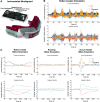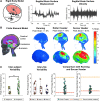Pilot Findings of Brain Displacements and Deformations during Roller Coaster Rides - PubMed (original) (raw)
Pilot Findings of Brain Displacements and Deformations during Roller Coaster Rides
Calvin Kuo et al. J Neurotrauma. 2017.
Abstract
With 300,000,000 riders annually, roller coasters are a popular recreational activity. Although the number of roller coaster injuries is relatively low, the precise effect of roller coaster rides on our brains remains unknown. Here we present the quantitative characterization of brain displacements and deformations during roller coaster rides. For two healthy adult male subjects, we recorded head accelerations during three representative rides, and, for comparison, during running and soccer headers. From the recordings, we simulated brain displacements and deformations using rigid body dynamics and finite element analyses. Our findings show that despite having lower linear accelerations than sports head impacts, roller coasters may lead to brain displacements and strains comparable to mild soccer headers. The peak change in angular velocity on the rides was 9.9 rad/sec, which was higher than the 5.6 rad/sec in soccer headers with ball velocities reaching 7 m/sec. Maximum brain surface displacements of 4.0 mm and maximum principal strains of 7.6% were higher than in running and similar to soccer headers, but below the reported average concussion strain. Brain strain rates during roller coaster rides were similar to those in running, and lower than those in soccer headers. Strikingly, on the same ride and at a similar position, the two subjects experienced significantly different head kinematics and brain deformation. These results indicate that head motion and brain deformation during roller coaster rides are highly sensitive to individual subjects. Although our study suggests that roller coaster rides do not present an immediate risk of acute brain injury, their long-term effects require further longitudinal study.
Keywords: brain modeling; head kinematics; traumatic brain injury; wearable sensors.
Conflict of interest statement
There was no significant financial support for this work that could have influenced its outcome. L.C.W., C.K., K.L., and D.B.C. are developing the Stanford Mouthguard as a research device to study mild TBI, and the findings of this study may help inform sensor design. L.C.W., C.K., and D.B.C. are also co-inventors on Stanford-owned patents related to instrumented mouthguard design, which are not directly related to this work.
Figures
**FIG. 1.
Use of instrumented mouthguards to record head kinematics during roller coaster rides. (A) Mouthguard, (B) linear acceleration of the head during the entire duration of a roller coaster ride, and (C) comparison of roller coaster accelerations with running and soccer heading.
**FIG. 2.
Use of rigid body dynamics and finite element modeling to estimate brain displacements and deformations. (A) Rigid body model and results, (B) finite element model and results, (C) comparison of brain deformations across subjects, rides, and activities.
Similar articles
- Head motions while riding roller coasters: implications for brain injury.
Pfister BJ, Chickola L, Smith DH. Pfister BJ, et al. Am J Forensic Med Pathol. 2009 Dec;30(4):339-45. doi: 10.1097/PAF.0b013e318187e0c9. Am J Forensic Med Pathol. 2009. PMID: 19901817 Free PMC article. - Roller coasters, g forces, and brain trauma: on the wrong track?
Smith DH, Meaney DF. Smith DH, et al. J Neurotrauma. 2002 Oct;19(10):1117-20. doi: 10.1089/08977150260337921. J Neurotrauma. 2002. PMID: 12427321 Review. - Roller Coaster-Induced Subdural Hematoma in a Previously Healthy Teenager.
Tseng P, Kearl YL, Ansari A. Tseng P, et al. Pediatr Emerg Care. 2019 Apr;35(4):e76-e78. doi: 10.1097/PEC.0000000000001802. Pediatr Emerg Care. 2019. PMID: 30870340 - Immediate and Transient Perturbances in EEG Within Seconds Following Controlled Soccer Head Impact.
Rezaei A, Wang T, Titina C, Wu L. Rezaei A, et al. Ann Biomed Eng. 2024 Oct;52(10):2897-2910. doi: 10.1007/s10439-024-03602-0. Epub 2024 Aug 13. Ann Biomed Eng. 2024. PMID: 39136891 - Roller coaster headaches revisited.
Huang PP. Huang PP. Surg Neurol. 2003 Nov;60(5):398-401. doi: 10.1016/s0090-3019(03)00296-9. Surg Neurol. 2003. PMID: 14572959 Review.
Cited by
- Physical Biology of Axonal Damage.
de Rooij R, Kuhl E. de Rooij R, et al. Front Cell Neurosci. 2018 Jun 6;12:144. doi: 10.3389/fncel.2018.00144. eCollection 2018. Front Cell Neurosci. 2018. PMID: 29928193 Free PMC article. - Bulging brains.
Weickenmeier J, Saze P, Butler CAM, Young PG, Goriely A, Kuhl E. Weickenmeier J, et al. J Elast. 2017 Dec;129(1-2):197-212. doi: 10.1007/s10659-016-9606-1. Epub 2016 Oct 24. J Elast. 2017. PMID: 29151668 Free PMC article. - The Shrinking Brain: Cerebral Atrophy Following Traumatic Brain Injury.
Harris TC, de Rooij R, Kuhl E. Harris TC, et al. Ann Biomed Eng. 2019 Sep;47(9):1941-1959. doi: 10.1007/s10439-018-02148-2. Epub 2018 Oct 17. Ann Biomed Eng. 2019. PMID: 30341741 Free PMC article. Review. - Cerebellar Stroke in a Young Adult Following an Amusement Park Ride.
Inam SHA, Chaychi MTM, Mannan MS, Hanson JE, Ferguson P, Nolte J. Inam SHA, et al. Cureus. 2023 Aug 26;15(8):e44165. doi: 10.7759/cureus.44165. eCollection 2023 Aug. Cureus. 2023. PMID: 37753051 Free PMC article. - Head Impact Kinematics and Brain Tissue Strains in High School Lacrosse.
Patton DA, Huber CM, Jain D, Kleiven S, Zhou Z, Master CL, Arbogast KB. Patton DA, et al. Ann Biomed Eng. 2024 Oct;52(10):2844-2853. doi: 10.1007/s10439-024-03513-0. Epub 2024 Apr 22. Ann Biomed Eng. 2024. PMID: 38649514
References
- Braksiek R.J., and Roberts D.J. (2002). Amusement park injuries and deaths. Ann. Emerg. Med. 39, 65–72 - PubMed
- Levenson M.S., Product U. S. C. & Commission S. (2002). Amusement ride-related injuries and deaths in the United States: 2002 Update. Consumer Product Safety Commission, Bethesda, MD
- Bo-Abbas Y., and Bolton C.F. (1995). Roller-coaster headache. N. Engl. J. Med. 332, 1585. - PubMed
- Fernandes C.M., and Daya M.R. (1994). A roller coaster headache: case report. J. Trauma 37, 1007–1010 - PubMed
Publication types
MeSH terms
LinkOut - more resources
Full Text Sources
Other Literature Sources

